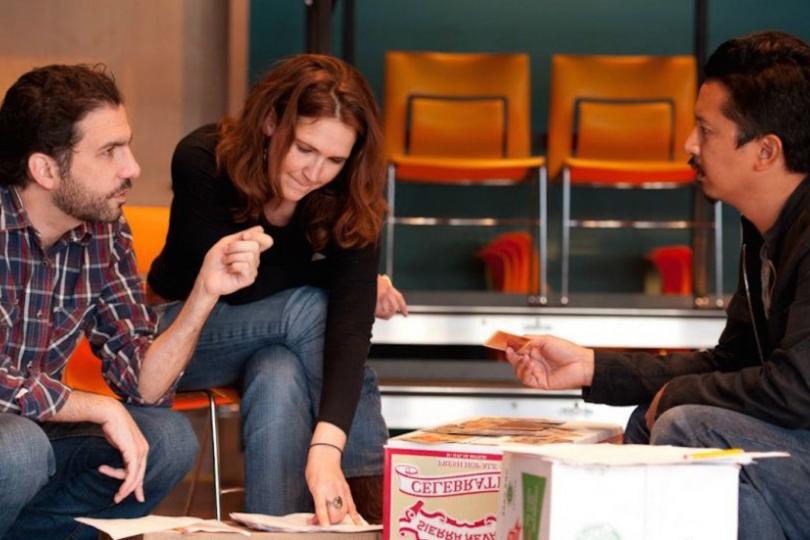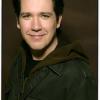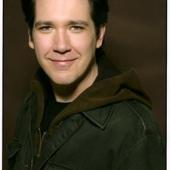Where many roads meet

If you watch children’s television, you know him as Randy the Planner on The Choo Choo Bob Show. If you go to local awards ceremonies, you know him as the two time co-host of the Ivies. If you go see plays around town you know him as the reliably kinetic actor who injects palpable life into whatever show he happens to be doing now.
But, of course, if you pay any attention at all, you know that Randy Reyes is the new Artistic Director of Mu Performing Arts. Though he maintains a punishing schedule that allows little to no time for the inessential, Randy took a breather with me at Spyhouse in Northeast.
How long have you been doing your current job at Mu Performing Arts?
This is my second season.
How’s it been going?
We’ve had a lot of transition since my first year. Mainly our Managing Director, so it takes some time to get her up to speed on what Mu does and how we do it. And as she gets used to what exists, she begins to change things according to how she wants them to work. Then we also have a new Communications Director and a new Development person and a new Admin person. So basically I’m the only one left in the office. And we got a new Artistic Director of Mu Daiko.
And all these things are necessary. I think when there’s a big change, it makes sense that the whole organization starts to transition, but it can make it more challenging to move forward on things. We have to make sure everyone knows what already exists before we can push it to where we want it to go.
I learned a tremendous amount my first year, just about the way a non-profit works and specifically the way a theater of color works within the system. I feel like that knowledge will help me move forward in a much more effective way.
What have been some of your biggest lessons learned?
I’ve been really thinking about our mission and who our audiences are and who are we doing it for. Because, yes we’re doing it for the larger theater community, that’s one of our audiences, but another important part of our audience is the Asian American community, specifically the Asian American community in Minnesota. And what are the realities of that community? The largest part of it is relatively new immigrant communities, so theater for them is not a viable form of entertainment, because they’re more worried about putting food on the table and education and shelter.
So that’s a reality. You have to know what your community is. And how do we get them interested in us, in the fact that we’re telling their stories, and that there is an empowering aspect about going to see a play done with, for and by Asians. Their idea of theater is an elite activity where they are mostly not welcome. How do I reach them, how do I respectfully engage them, how do I get to know them? So we’ve put programs in for that.
And understanding how funding gets done. There’s a lot of talk right now about diversity and inclusion. And Mu has a very strong definition of what that is; it’s part of our mission and it has been for 23 years. So it’s interesting for me to hear how other organizations are starting to use those terms and what it means to them, because that effects funding, who gets the money. There are people being funded for diversity and inclusion work, and I see the difference in the way that they do it and the way that we have done it, the way that it’s a part of our mission. So that’s been interesting and a big learning curve.
Also ticket sales and the kind of shows I want to do. I need to pay attention to Asian American playwrights and make sure I think about diversity within that group as well. And also give Asian American artists an opportunity to do things. I’m trying to get out of the model of, We need a big show to make us money. Well, our big shows cost us money. So I need to start thinking about things in a more mission-based way, and not in the way that older models have been set up for making money and surviving in theater.
So I’m really trying to rethink what that means and what are the most effective ways of engaging with this unique community; what kind of shows are we going to do that are different than what other theaters are offering, not only in terms of the content but also in terms of the artistry; and with funding, how do I tell our story within the landscape of foundations and grants and how they’re set up.
How do you deal with the steep challenge that the terms Asian and Asian American are themselves so broad? How do you deal with the fact that there are diverse subsets of identity within what you’ve identified as a subset of your core audience?
I gave you the general challenge that Asian audiences don’t come see theater. Those that do are only interested in seeing shows that they see as being specifically about them, by the specific culture that they identify with. What we’re trying to say is that we have something in common as Asian Americans. That is a unique experience, because in America they haven’t yet found a way to distinguish each of us. Because of that, we have a shared experience, and we need to start talking about the themes and experiences that unify us.
So we’re trying to do that through workshops as well, and say, yeah, this might be a Hmong play, but these are the themes that they’re talking about and that is valid to all of us. And I feel like that conversation can continue on to, These themes are all universal, because everyone here is part of an immigrant experience whether they want to believe it or not.
And actually the Asian American story is actually more “American” than some “American” stories are.
When we first met I knew you as an actor and since then you have become a director and now an artistic director of a theater. How would describe your evolution as an artist? And how do you balance your ongoing freelance career while being Mu’s Artistic Director?
I’ve grown as an artist, but in more ways I’ve grown as a whole person. I had very little connection with my cultural identity or how other people saw me, with my Filipino side as an artist. At all. If anything I tried to ignore it or tried to make myself believe I was white just like anybody else. And I realized that ended up limiting me in my full expression as an artist, because there was a side of me that I was not accepting. Once I started accepting that side of me and funneling everything through that, I started to be able to use myself. And as you know, as an actor, that’s what it’s all about: being able to use yourself. I realized that when you deny yourself, in part, you cannot access yourself.
I feel like the work that I’ve been doing at Mu, where I’ve really developed what that is, my identity through the Asian American perspective, really peaked in the season that I did that included The Romance of Magno Rubio, Yellowface, and M Butterfly. That year was my biggest growth, not only as an artist, but as a person.
What’s frustrating sometimes now is that I get asked to talk on panels, but it’s mostly about the social justice work we’re doing, and I’m dying to talk about the art. I think a lot about that too, and I have ideas about what it means to be an Asian American artist, now, in American theater. So now that’s part of my life and you can’t separate the two, and that’s the beauty of it and that’s the challenge of it. Sometimes I just want to be in rehearsal. Sometimes I don’t want to think about what does this mean in the larger view of Identity and Theater. Sometimes I just want to act, to do a play, and I can’t separate those two things anymore. But I’ve become a much more complete person and artist because of it.
For the second question, I feel like I’ve always had more than one project going on. You know what it’s like as a teaching artist and actor in the Twin Cities: you supplement things. And luckily, I’ve always had a little part time job at Mu and then projects. Now, there’s just no free thinking space. Now I always have something to think about which is Mu. And I do other projects once in a while, if it fits in, but I feel like that feeds me too and it keeps me connected to the community. I feel like there’s a danger that I could get isolated in the Mu Performing Arts world and lose a realistic sense of what’s going on in the community. So right now, they feed me. I just have less time to think.
What are the artistic things that you want to talk about, that are exciting you? And what are the things from Mu’s history that you wanted to safeguard and what new directions and visions are you trying to head toward?
Working at Mu, we have a limited acting pool. There’s a luxury to being able to pick a play and have choices of actors to hire, choices more than 1 or 2. That’s a luxury and a privilege that I feel doesn’t get talked about enough. In Mu I’m very limited in the actors I can hire and the plays that I can choose from. And there’s limitations for everyone in the plays that they can choose, but especially with theaters of color or LGBTQI specific theaters or disabled theaters, their choices become much more limited, and they’re reliant on creativity and a small group of people to make art.
What goes with that too, is that we know no one else is telling our story, so we care about it in, I feel, a much deeper way. And I’ve worked with other theaters and it’s not that they don’t care about the work that they do, but it comes from a different place than, We know we’re the only ones telling this story and I’ve never been able to tell this story and I’m not going to be able to tell this story outside of this theater. That’s always been at the heart of Mu, that passion, that heart, how important it is.
Now, I want to start to work on what is the aesthetic we bring that’s uniquely Asian American. That’s what I’m really in right now. How do we do Twelfth Night? What do we bring to it beyond just a look? How can we capture the Asian American experience through the art? And I don’t have an answer. I don’t know what that is, but that’s my journey now.
Given that evolving sense of yourself as an artist and person, when you’re doing a play, purely as an actor, at a theater that isn’t Mu, is it different than it used to be?
Even in the time when I was working a lot at the Guthrie, I had a sense of change in terms of how I felt in those rooms. I bring more of myself into those rooms now. I’m not there to change their process, I just need to do it for me. So if I happen to be part of a family where I have a white dad and an Asian mom or a black mom and a white dad, in the past, if the director didn’t want to talk about that, thought they were just going to do color blind casting and have diversity onstage, I would just let that be what it is. Now if I’m in that situation, I would want to talk about how does that dynamic change with me being Asian and my parents looking different.
I’ve also directed for other companies where, if that’s the situation, I want to talk about that. What it does is it carves a place for these actors, and by not talking about it, you never really know why you’re there.
For years I did Christmas Carol, and I was just like, I’m a Dickensian citizen! I’d get paired up for a crossover and my wife would be black and my kid would be white, and I’m going along and singing. I remember the last couple of years I did it, I felt like I didn’t belong there. No one’s acknowledged the way that I look, that it’s different but it’s okay. So I started to talk with my scene partners and tried to give myself an identity: my father came here from the spice trade in China, settled into this place, decided to stay here and raise a family; so I was raised here and speak native English; and I met my wife here and this is our adopted son; or this is my real son and this is how he turned out. Whatever it is. I needed to create a world for myself where I felt like I belonged.
I need to do that now with every project. Race and the way you look, that cannot just happen in a vacuum. You can’t just have a diverse cast onstage and leave it at that, I think it becomes more dangerous. You have to have a conversation.
So the people who continue to hire me, who want to work with me, I think find that as a value.
It’s not about being a trouble maker, like, here comes Randy talking about his politics again. I’m just trying to feel like I belong in a world. I need to do that with every project I’m in.




